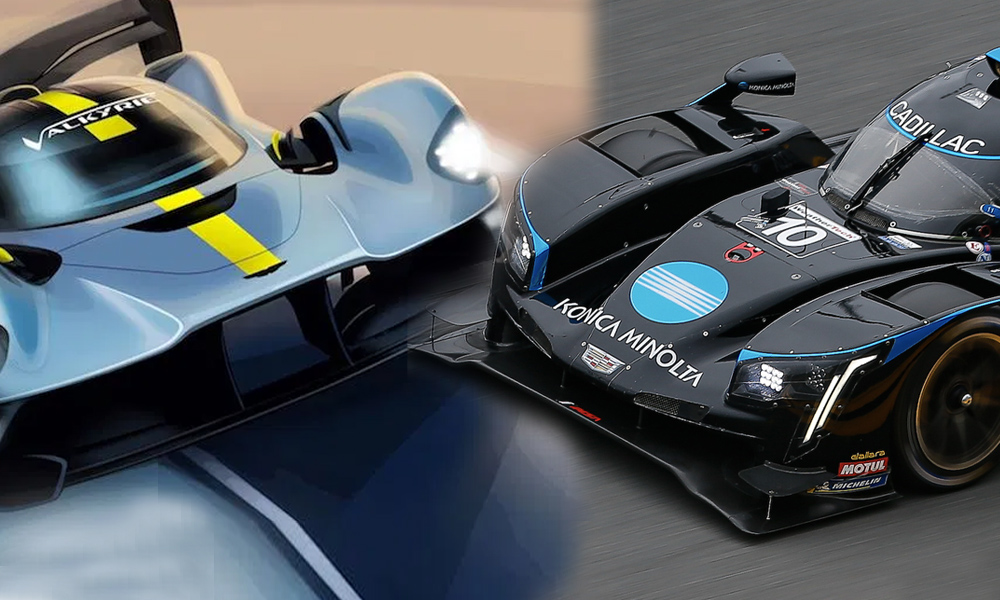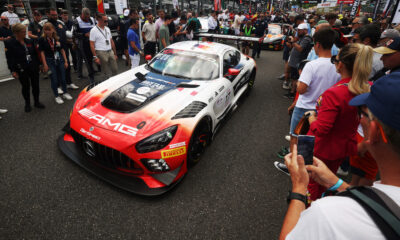
Image:AMR/IMSA
The ACO and IMSA have confirmed convergence of the top prototype categories of endurance racing that will see the creation of the LMDh platform to race alongside the soon-to-debut Le Mans Hypercar formula in the FIA World Endurance Championship.
Announced Friday at Daytona International Speedway by ACO President Pierre Fillon and IMSA Chairman Jim France, the historic agreement will allow the same top-class prototypes to be eligible in both the WEC and the WeatherTech SportsCar Championship, beginning with the 2021-22 WEC season and in 2022 in IMSA competition.
The two sanctioning bodies unveiled the “guiding principles” of the LMDh platform, which will be based on a new chassis common to both the ACO and IMSA that utilizes elements of the Le Mans Hypercar and LMP2 chassis.
LMDh effectively replaces what had been called DPi 2.0 or DPi 2022 in the development process of IMSA’s next-generation prototype platform.
The cars will be built by the four current LMP2 constructors: Dallara, Ligier Automotive, ORECA and Multimatic and will feature a spec KERS-based hybrid system on the rear axle with the design and styling to be developed according to the engine manufacturer.
The same chassis will be utilized in the next generation of LMP2 regulations, which is due in 2022.
Further technical details of the platform, which will race alongside Le Mans Hypercar entries via a Balance of Performance system, will be revealed during the ‘Super Sebring’ event in March by the ACO and IMSA technical departments.
Fillon said today’s announcement forms a “crucial” starting point for the future of endurance racing worldwide.
“The platform represents the convergence achieved by both organizations which is a great success story for endurance racing,” he said.
“A manufacturer will soon be able to compete in the top category of two championships, the FIA WEC and the WeatherTech Championship.
“We can’t emphasize enough, as it’s exceptional, how many opportunities this long-term sporting and marketing vision will open up.”
France added: “When my father, Bill France Sr., brought the first Daytona Continental sports car race here to Daytona International Speedway back in 1962, he wanted to bring together sports car drivers, teams and manufacturers from around the world.
“With the ACO, IMSA and manufacturers aligned, today’s announcement proudly takes my father’s vision to the next level.”
While having been one of the hottest topics of sports car racing in recent years, the most recent round of convergence talks began in earnest last summer, with IMSA and the ACO reportedly agreeing to a deal in principle in December.
The LMDh platform is understood to have taken the primary elements from IMSA’s technical working group meetings with manufacturers, which have largely supported the implementation of a global platform.
McLaren, Ford, Lexus, Lamborghini, among others, have been vocal on the need for a common global prototype platform in order to commit to a top-class program.
“Providing a common platform for top-level prototype racing globally has been a goal for the sanctioning bodies, our manufacturers – and most importantly, sports car racing fans everywhere – for many years, and we are proud to say the opportunity has finally arrived,” said IMSA President John Doonan.
“We are grateful for the collaboration with our partners at the ACO and the open dialogue with our manufacturer partners that led us to today’s introduction of the LMDh platform.”
WEC CEO Gerard Neveu is understood to have been a proponent of IMSA’s DPi platform from the onset.
“The two sanctioning bodies should be congratulated for their vision and spirit of collaboration,” he said.
“Le Mans Hypercars and the new LMDh cars racing together at Le Mans or Daytona will be an incredibly exciting prospect for endurance fans across the world.”
The Le Mans Hypercar class, which is set to debut in September for the 2020-21 WEC season, will run to its planned five-season homologation cycle until 2026.























